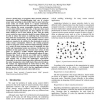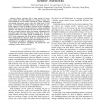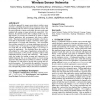21 search results - page 3 / 5 » Sleep scheduling with expected common coverage in wireless s... |
IJSNET
2006
13 years 5 months ago
2006
: In this paper, we present a two-tiered scheduling approach for effective energy conservation in wireless sensor networks. The effectiveness of this mechanism relies on dynamicall...
CN
2010
13 years 5 months ago
2010
The dynamic point coverage problem in wireless sensor networks is to detect some moving target points in the area of the network using as little sensor nodes as possible. One way ...
JIPS
2006
13 years 5 months ago
2006
In this paper, we proposed a MAC protocol, which can dynamically adjust Listening/Sleeping time rate of wireless sensor nodes according to data traffic load. In sensor networks, se...
VTC
2008
IEEE
13 years 11 months ago
2008
IEEE
— Sensor networks with a large amount of sensor nodes usually have high redundancy in sensing coverage. The network lifetime can be further extended by proper scheduling and putt...
SENSYS
2003
ACM
13 years 10 months ago
2003
ACM
An effective approach for energy conservation in wireless sensor networks is scheduling sleep intervals for extraneous nodes, while the remaining nodes stay active to provide cont...



